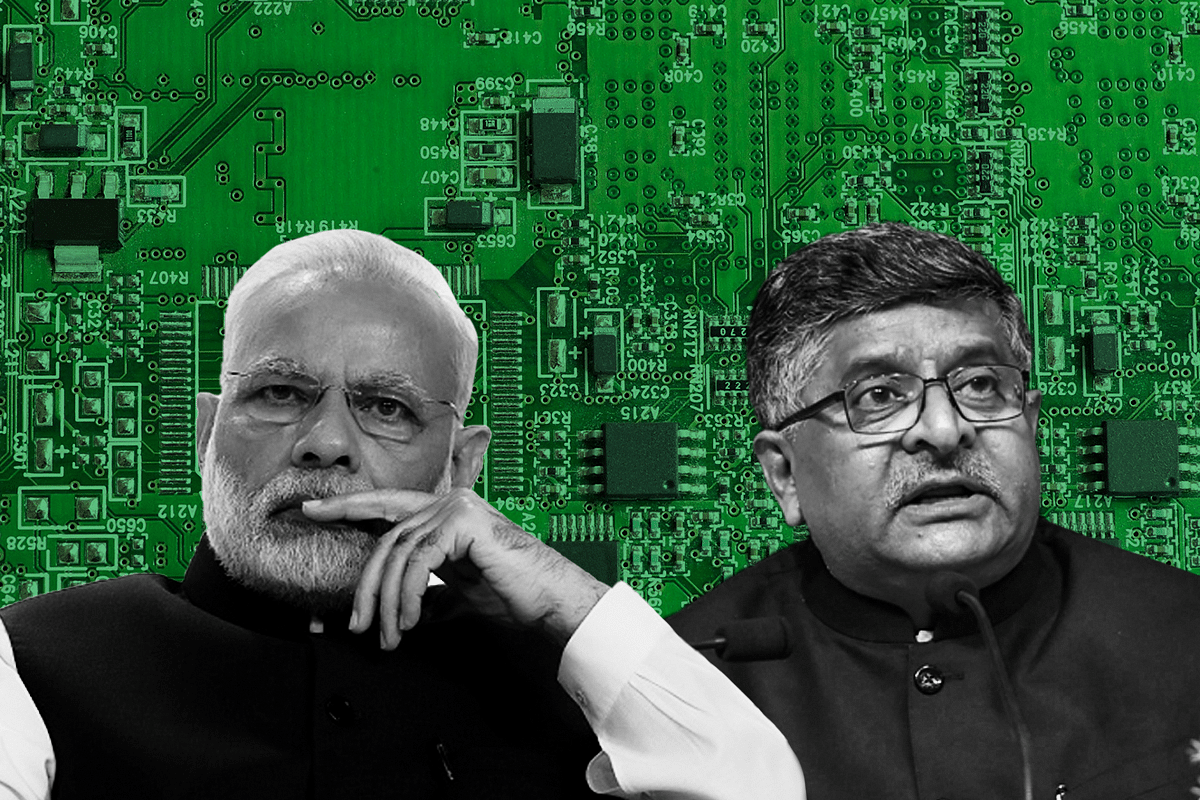Ideas
This Report Of An India-Israel Forum Had Specific And Practical Recommendations For #FabInIndia: Here Are The Highlights
- For India, it is about going from near 0 per cent to maybe 10 per cent by 2025 in terms of manufacturing chips that it needs, and hopefully scaling further from there and starting to show up on the global map.
- To kick-start commercial semiconductor fabs or foundries, some amount of government hand holding will be needed.

Prime Minister Narendra Modi and Minister Ravi Shankar Prasad.
An Indo-Israel study had suggested 45nm/65nm foundry as a starting point for #FabInIndia: $0.9 billion subsidy and $1.1 billion interest free loan were sought.
A 5 August news report said that "China introduces new policies to support integrated circuit industry".
An analysis in CNBC following China's measures said, “analysts have cast doubt over whether the policies will have a major impact in helping China’s chip industry". However, one must note that the analysis is with respect to China's possibility of becoming a global player in semiconductor chip (IC) manufacturing, where currently it is at a near 5 per cent.
China has set an ambitious target by 2025 of producing in-house 70 per cent of what it consumes where currently it is at a likely 20 per cent.
For India, on the other hand, it is about going from near 0 per cent to maybe 10 per cent by 2025 in terms of manufacturing the chips that it needs and hopefully scaling further from there and starting to show up on the global map.
To get the start in India for commercial semiconductor fabs or foundries, some amount of government hand holding will be needed. While we continue to look forward to when the government of India may finalise and announce its new wafer or chip fab policy and incentives, here is some bit of information from an event that occurred eight months back.
A report of The 12th India Israel Forum held in Tel Aviv 16-17 December 2019 under the auspices of "Ananta Center", a "nonpartisan trust that works to create a strong and open society through ethical leadership and constructive dialogues" can be accessed at here. Some excerpts from the report which are relevant for the possibility of a semiconductor chip (IC) manufacturing #FabInIndia are being reproduced here for readers and for relevant people to act upon.
As a background to the effort, the December 2019 report mentions the following:
Now from the "key findings and recommendations" section, to begin with the why of it as well as the benefits of having a full-fledged commercial #FabInIndia:
On the ‘what’ and ‘how’ to get a #FabInIndia started, the report has the following recommendations (bold emphasis is mine):
An analogue and mixed-signal foundry at a technology node of 45/65 nm, could be a starting point for India to develop a semiconductor fabrication industry. Israel as a technology partner could transfer the initial technology, provide support to set-up the fab and support early market development.
The report has the following to say on what kind of impact it could have on the electronics imports of India and on the Indian economy in general:
The Forum assesses the proposed fab may offset semiconductor imports of US$ 8 billion over the projection period and may have a further multiplier impact of US$ 15 billion on the Indian economy.
So what should the government of India and investors do to help get this going? The report has very specific recommendations and suggested numbers:
Monetary and non-monetary support will be needed from the Government of India, to attract investment in the proposed India fab. As per the financial model in the report, a cash subsidy of US$ 912 Mn on capex and an interest-free loan of US$ 1,089 Mn, could help achieve 15% equity IRR, the likely threshold for corporate investors.
The government should also provide all necessary support in terms of connectivity, infrastructure, preferential market access, etc.
Need to have a steady financial private partner to set up a Fab. The private partner could have equity to ensure that there is a responsible stakeholder.
The recommendations from the report on “Feasibility Study of a Semiconductor Fabrication Facility in India” needs to be taken up at the next level and a consortium could be built around it. India can work with Israel to create a roadmap towards its implementation.
The report often quotes from what appears to be a detailed "Feasibility Study of a Semiconductor Fabrication Facility in India" . It is not clear if the study is or will be available in the public domain and more importantly if it will be acted upon. Previous articles in Swarajya also independently concurred with many of the above recommendations.
Swarajya has a dedicated issue on the topic of a possible upcoming "silicon revolution" in India for which indeed #FabInIndia is the key. The issue has a detailed interview with minister Ravishankar Prasad where he confirmed that a new policy for semiconductor fabs in India is in the making.
The hope is that the Narendra Modi government, which has so far been able to address many long pending matters, can soon help #FabInIndia take off as well.
Introducing ElectionsHQ + 50 Ground Reports Project
The 2024 elections might seem easy to guess, but there are some important questions that shouldn't be missed.
Do freebies still sway voters? Do people prioritise infrastructure when voting? How will Punjab vote?
The answers to these questions provide great insights into where we, as a country, are headed in the years to come.
Swarajya is starting a project with an aim to do 50 solid ground stories and a smart commentary service on WhatsApp, a one-of-a-kind. We'd love your support during this election season.
Click below to contribute.
Latest